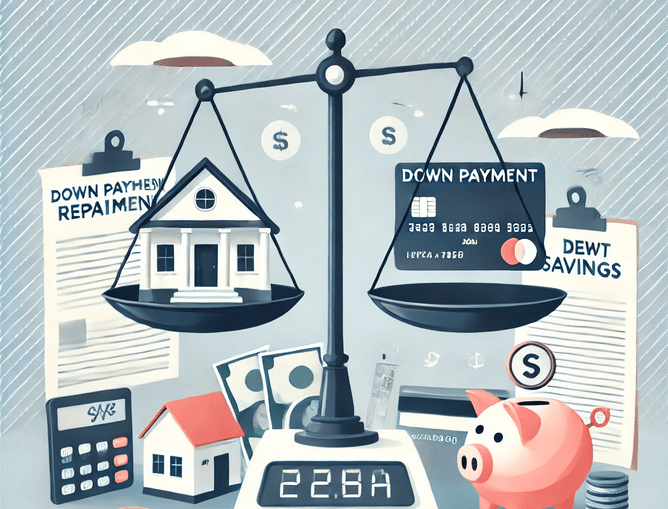One of the biggest challenges for future homeowners is finding the right balance between paying down debt and saving for a down payment. Both are essential to securing a mortgage, but prioritizing one can sometimes feel like you’re sacrificing progress on the other. Here, we’ll explore strategies to manage both effectively, keeping your finances mortgage-ready and helping you reach your home ownership goals.
1. Assess Your Financial Goals and Priorities
The first step to balancing debt repayment with down payment savings is understanding your financial goals. Start by asking yourself some questions:
What’s your target down payment amount, and by when do you want to reach it?
How much debt do you currently have, and are any debts high-interest?
What is your timeline for purchasing a home?
Setting clear goals will help you prioritize where your money should go each month. If buying a home is your top goal within a year or two, it may make sense to focus on saving more aggressively. However, if high-interest debt is a financial burden, paying it down may need to be your first priority.
2. Create a Budget That Accommodates Both Goals
Once you have clarity on your financial goals, create a budget that allocates funds toward both debt repayment and down payment savings. Consider the following tips:
Set a monthly savings target for your down payment: Aim for a specific percentage of your income, adjusting based on your goals and timeline.
Prioritize high-interest debt: Direct extra funds toward high-interest debts, as reducing these can free up more money for savings in the long run.
By tracking your monthly income and expenses, you’ll have a clearer picture of where you can cut back to balance both goals.
3. Take Advantage of Employer Contributions and Automated Savings
If your employer offers a savings plan, like an RRSP matching program, consider leveraging this benefit. Contributing to a tax-advantaged account like an RRSP (Registered Retirement Savings Plan) allows you to save for a down payment (as part of the Home Buyers’ Plan in Canada) while also reducing your taxable income. If you later withdraw from the RRSP to buy your first home, you can use those funds as part of your down payment.
Additionally, setting up an automated savings transfer each month can make it easier to consistently build your down payment fund.
4. Pay Off High-Interest Debt First
While balancing savings and debt repayment is ideal, some debts—like credit cards or payday loans—can cost you significantly in the long run if they’re not addressed promptly. Prioritize paying down these high-interest debts first to reduce the amount of interest you pay over time. As your high-interest debt decreases, you’ll free up more funds to put toward savings.
Tip: When high-interest debt is out of the way, you can redirect those monthly payments into your down payment savings fund.
5. Avoid Accumulating New Debt
One of the best ways to keep your debt under control is to avoid taking on any new debt as you work toward home ownership. New debt can lower your credit score, increase your debt-to-income ratio, and ultimately reduce the amount you’re able to borrow for a mortgage. Staying debt-free helps you make steady progress on both debt repayment and savings.
Tip: Keep your current credit accounts in good standing, but try to avoid opening any new credit lines until after you’ve purchased your home.
6. Focus on Building a Strong Emergency Fund
An emergency fund can help prevent you from falling back on credit during unexpected expenses. While it may seem counterintuitive to save separately from your down payment, having an emergency fund provides financial stability and ensures that your down payment savings remain intact if an unexpected cost arises.
Aim to set aside three to six months’ worth of expenses in a high-interest savings account. Even a small emergency fund can help you avoid credit card debt and protect your down payment fund.
7. Reevaluate and Adjust as Needed
Financial circumstances and priorities can change, so it’s essential to reevaluate your debt repayment and savings strategy regularly. Check your budget every few months to see if you’re on track with your goals, and adjust your plan as needed.
For instance, if you get a raise or a bonus, consider putting a portion of it toward your down payment or debt repayment. Staying flexible with your approach allows you to adapt to life’s changes while staying on track toward home ownership.
Final Thoughts
Balancing debt repayment with down payment savings may seem challenging, but it’s achievable with the right strategies. By setting clear goals, creating a budget, paying down high-interest debt, and taking advantage of employer programs and automated savings, you can make steady progress on both fronts. The key is to stay consistent, avoid accumulating new debt, and be prepared to adjust as needed.
If you’d like personalized guidance on balancing these goals or have questions about your mortgage readiness, don’t hesitate to reach out. I’m here to help you make smart financial decisions on your path to home ownership.

